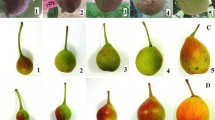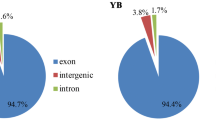Abstract
The color of fruit skin is an important quality parameter, and in many plants, it is the result of coordinative regulation of the anthocyanin pathway. To characterize the mechanism involved in fruit peel coloration of Yunnan red pear (Pyrus pyrifolia), we constructed a subtractive cDNA library using the suppression subtractive hybridization (SSH) technology. cDNA of red peel exposed to sunlight (for 2, 4, 6, and 8 days) was subtracted from that of white skin unexposed to sunlight. Over 100 differentially expressed ESTs were obtained, putatively involved in primary and secondary metabolism, stress, and defense response. Expression analysis using semiquantitative reverse transcription polymerase chain reaction (RT-PCR) for 13 genes was performed with two pear cultivars, light-skinned ‘Zaobaimi’ and red-skinned ‘Yunhong-1’, which had been bagged and then exposed to sunlight for 0, 1, 2, 3, 5, and 7 days before harvest. This analysis showed that genes encoding for a metallothionein-like protein and a NADP-malic acid enzyme were constitutively expressed, whereas other selected genes were either down- or up-regulated. Semiquantitative RT-PCR analysis for 7 anthocyanin biosynthetic pathway genes and 3 putative regulatory genes was also performed. Results showed that an R2R3 MYB transcription factor PyMYB10 was up-regulated in both the less-colored pear ‘Zaobaimi’ and well-colored red pear Yunhong-1 after the bag was removed, but that kinetics differed between cultivars. Other anthocyanin-related genes appeared to be coordinately regulated by the MYB–bHLH–WD40 complex. DFR and ANS genes seemed to be limiting factors for the peel coloration of less-colored pear ‘Zaobaimi’, while all biosynthetic steps are up-regulated by 7 days after bag removal in red fruit. This study suggests the regulation of red pear coloring is via differential effects of the MYB–bHLH–WD40 complex on the pear anthocyanin pathway genes.




Similar content being viewed by others
References
Clendennen SK, May GD (1997) Differential gene expression in ripening banana fruit. Plant Physiol 115(2):463–469
Dayton DF (1966) The pattern and inheritance of anthocyanin distribution in red pears. J Proc Am Soc Hortic Sci 89:110–116
Diatchenko L, Lau YF, Campbell AP, Chenchik A, Moqadam F, Huang B, Lukyanov S, Lukyanov K, Gurskaya N, Sverdlov ED, Siebert PD (1996) Suppression subtractive hybridization: a method for generating differentially regulated or tissue-specific cDNA probes and libraries. Proc Natl Acad Sci USA 93(12):6025–6030
Dussi MC, Sugar D, Wrolstad RE (1995) Characterizing and quantifying anthocyanins in red pears and the effect of light quality on fruit color. J Amer Soc Hort Sci 120(5):785–789
Espley RV, Hellens RP, Putterill J, Stevenson DE, Kutty-Amma S, Allan AC (2007) Red colouration in apple fruit is due to the activity of the MYB transcription factor, MdMYB10. Plant J 49(3):414–427
Feng S, Wang Y, Yang S, Xu Y, Chen X (2010) Anthocyanin biosynthesis in pears is regulated by a R2R3-MYB transcription factor PyMYB10. Planta 232(1):245–255
Ferguson IB, Lurie S, Bowen JH (1994) Protein synthesis and breakdown during heat shock of cultured pear (Pyrus communis L.) cells. Plant Physiol 104(4):1429–1437
Fils-Lycaon BR, Wiersma PA, Eastwell KC, Sautiere P (1996) A cherry protein and its gene, abundantly expressed in ripening fruit, have been identified as thaumatin-like. Plant Physiol 111(1):269–273
Fischer TC, Gosch C, Pfeiffer J, Halbwirth H, Halle C, Stich K, Forkmann G (2007) Flavonoid genes of pear (Pyrus communis). Trees-Struct Funct 21(5):521–529
Gao ZS, Weg WE, Schaart JG, Arkel G, Breiteneder H, Hoffmann-Sommergruber K, Gilissen LJ (2005) Genomic characterization and linkage mapping of the apple allergen genes Mal d 2 (thaumatin-like protein) and Mal d 4 (profilin). Theor Appl Genet 111(6):1087–1097
Gonzalez A, Zhao M, Leavitt JM, Lloyd AM (2008) Regulation of the anthocyanin biosynthetic pathway by the TTG1/bHLH/Myb transcriptional complex in Arabidopsis seedlings. Plant J 53(5):814–827
Goodman CD, Casati P, Walbot V (2004) A multidrug resistance-associated protein involved in anthocyanin transport in Zea mays. Plant Cell 16(7):1812–1826
Ho VS, Wong JH, Ng TB (2007) A thaumatin-like antifungal protein from the emperor banana. Peptides 28(4):760–766
Jia HJ, Araki A, Okamoto G (2005) Influence of fruit bagging on aroma volatiles and skin coloration of ‘Hakuho’ peach (Prunus persica Batsch). Post Harvest Biol Technol 35:61–68
Kim SH, Lee JR, Hong ST, Yoo YK, An G, Kim SR (2003) Molecular cloning and analysis of anthocyanin biosynthesis genes preferentially expressed in apple skin. Plant Sci 165(2):403–413
King MC, Cliff MA (2002) Development of a model for prediction of consumer liking from visual attributes of new and established apple cultivars. J Am Pomol Soc 56(4):223–229
Liu D (2007) Molecular cloning and expression analysis of the genes specifically expressed in fibers of Gossypium hirsutum. Huazhong Agricultural University:27
Matsumura H, Watanabe S, Harada K, Senda M, Akada S, Kawasaki S, Dubouzet EG, Minaka N, Takahashi R (2005) Molecular linkage mapping and phylogeny of the chalcone synthase multigene family in soybean. Theor Appl Genet 110(7):1203–1209
Morita Y, Saitoh M, Hoshino A, Nitasaka E, Iida S (2006) Isolation of cDNAs for R2R3-MYB, bHLH and WDR transcriptional regulators and identification of c and ca mutations conferring white flowers in the Japanese morning glory. Plant Cell Physiol 47(4):457–470
Niu SS, Xu CJ, Zhang WS, Zhang B, Li X, Lin-Wang K, Ferguson IB, Allan AC, Chen KS (2010) Coordinated regulation of anthocyanin biosynthesis in Chinese bayberry (Myrica rubra) fruit by a R2R3 MYB transcription factor. Planta 231(4):887–899
Palapol Y, Ketsa S, Kui LW, Ferguson IB, Allan AC (2009) A MYB transcription factor regulates anthocyanin biosynthesis in mangosteen (Garcinia mangostana L.) fruit during ripening. Planta 229(6):1323–1334
Park KI, Ishikawa N, Morita Y, Choi JD, Hoshino A, Iida S (2007) A bHLH regulatory gene in the common morning glory, Ipomoea purpurea, controls anthocyanin biosynthesis in flowers, proanthocyanidin and phytomelanin pigmentation in seeds, and seed trichome formation. Plant J 49(4):641–654
Peng G, Wang GY, Zhao HJ, Fan L, Tao YZ (2003) Isolation and identification of submergence-induced genes in maize seedling by suppression subtractive hybridization. Acta Bot Sin 45(4):479–483
Steyn WJ, Holcroft DM, Wand SJE, Jacobs G (2004a) Anthocyanin degradation in detached pome fruit with reference to preharvest red color loss and pigmentation patterns of blushed and fully red pears. J Amer Soc Hort Sci 129(1):13–19
Steyn WJ, Holcroft DM, Wand SJE, Jacobs G (2004b) Regulation of pear color development in relation to activity of flavonoid enzymes. J Amer Soc Hort Sci 129(1):6–12
Steyn WJ, Wand SJE, Holcroft DM, Jacobs G (2005) Red colour development and loss in pears. Acta Hort 671:79–85
Tsuda TYM, Honda C, Moriguchi T (2004) Expression of anthocyanin biosynthesis genes in the skin of peach and nectarine fruit. J Am Soc Hortic Sci 129:857–862
Walker AR, Lee E, Bogs J, McDavid DAJ, Thomas MR, Robinson SP (2007) White grapes arose through the mutation of two similar and adjacent regulatory genes. Plant J 49(5):772–785
Xu ZR, Li YH (2006) Screening the genes associated with anthocyanin biosynthesis in roots of ‘Tsuda’ turnip using cDNA microarray. Yi Chuan 28(9):1101–1106
Zhou B, Li Y, Xu Z, Yan H, Homma S, Kawabata S (2007) Ultraviolet A-specific induction of anthocyanin biosynthesis in the swollen hypocotyls of turnip (Brassica rapa). J Exp Bot 58(7):1771–1781
Acknowledgements
This work was supported in part by the foundation (2006PY01-10) from Yunnan province and Kunming University of Science and Technology for Training Adult and Young Leaders of Science and Technology and by the foundation from the earmarked fund for modern Agro-industry Technology Research System.
This article is distributed under the terms of the Creative Commons Attribution Noncommercial License, which permits any noncommercial use, distribution, and reproduction in any medium, provided the original author(s) and source are credited.
Author information
Authors and Affiliations
Corresponding authors
Rights and permissions
About this article
Cite this article
Zhang, X., C Allan, A., Yi, Q. et al. Differential Gene Expression Analysis of Yunnan Red Pear, Pyrus Pyrifolia, During Fruit Skin Coloration. Plant Mol Biol Rep 29, 305–314 (2011). https://doi.org/10.1007/s11105-010-0231-z
Published:
Issue Date:
DOI: https://doi.org/10.1007/s11105-010-0231-z




